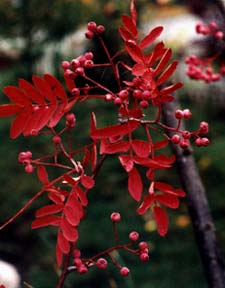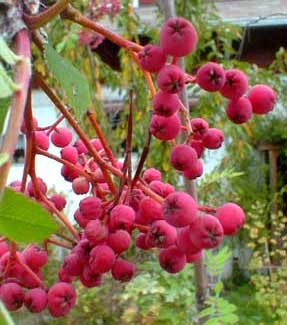 | |
|
O rowan tree, O rowan tree! thou'lt aye be dear to me! Intwined thou art wi' mony ties o' hame & infancy. Thy leaves were aye the first o' spring, thy flowers the simmer's pride; There wasna bonnie tree in a' the country side. O rowan tree! How fair wert thou in simmer time, wi' a' thy clusters white, How rich & gay thy autumn dress, wi' berries red & bright! On thy fair stem were mony names which now nae mair I see, But they're engraven on my heart-- forgot they ne'er can be! O rowan tree! We sat aneath thy spreading shade, the bairnies round thee ran, They pu'd thy bonnie berries red, & necklaces they strang. My mother! O I see her still, she smiled our sports to see, Wi' little Jeanie on her lap, & Jamie at her knee. O rowan tree! İO there arose my father's prayer, in holy evening's calm; How sweet was then my mother's voice in the Martyr's psalm! Now a' are gane! we meet na mair aneath the rowan tree! But hallowed thoughts around thee twine o' hame & infancy. O rowan tree! -Lady Carolina Oliphant Nairne | |
'Coral Fire'
Chinese Mountain Ash or Rowan
This November picture shows a limb of the Chinese Mountain Ash (Sorbus hupehensis) in the full glory of its Autumn coloration, pink-red leaves that stay on the branches all through Fall, & bright pink berries that last through winter.
Our sapling was twelve feet tall when first planted in 2002, & was mostly just a slender trunk, with all of its leaves & branches up top. It should some day grow to 20 feet or more, quite a small tree which gives a delicate impression.
My great-grandma had a large native mountain ash (probably the locally wild S. scopulina) in her front yard which all the grandchildren played in, so I've always had a soft spot for these trees, & was on the look-out for a pleasing specimen.
Because Granny Artemis & I already had so many orange- & red-berrying bushes & trees, we decided to go for a slightly odd cultivar rather than stick to the common mountain ash.
So we ended up with the cultivar 'Coral Fire' which must have the most striking autumn foliage of any variety, with the berries on the salmon-pink side of the color scale rather than the usual orange or red, each round berry having a star-shape pattern on the bottom.
The leaves are shiny green in spring & autumn. It also has reddish bark when young, but this feature is decreasingly evident as the tree matures.
'Coral Fire' is propagated by grafting onto rootstock of European Mountain Ash (S. aucuparia) & won't grow true from seeds.
This Asian species, native of western & central China, just like our own native Western Mountain Ash, does have minor drawbacks. They're not notably longlived trees, 25 to 50 years on average, so it's not a tree for posterity. The limbs can be fairly brittle; my grandmother's mountain ash lost a couple major limbs from the climbing & hanging antics of children.
But in 'Coral Fire's' favor, as it grows it remains rounded without need of pruning; it is hardy on the roadside & stays small enough to be safely planted under telephone wires; autumn leaf colors & berries are unbeatable for the genus; & it has rapid growth of a foot or eighteen inches a year. The Royal Horticultural Society thought well enough of it to bestow upon it the Award of Garden Merit.
In early spring it likes a bit of fertilizer but demands little else. Spring's scented white flowers appeal to hummingbirds & butterflies. Flowers are followed by green berries that fade to white through summer then take on their remarkable coral coloration by October, the leaves turning bright pink by November.
 In the ancient fable of "The Fox & the Grapes," when the Fox finally gives up on the grapes, he announces that they were undoubtedly in any case sour grapes. The actual fruit the fox is alluding to is the Ash Tree's Rowanberry, at least according to a Swedish saying, "Sour, as the fox calls rowanberries."
In the ancient fable of "The Fox & the Grapes," when the Fox finally gives up on the grapes, he announces that they were undoubtedly in any case sour grapes. The actual fruit the fox is alluding to is the Ash Tree's Rowanberry, at least according to a Swedish saying, "Sour, as the fox calls rowanberries." Though Granny Artemis & I have no intent to harvest Rowanberries from our tall sapling of an Ash Tree, the fruit is in fact an edible pome. A poem is like a teency apple & not a true berry. Sundry species of Mountain Ash have had their berries used to make wines, vodka, jams, & sauces. Amateur brewers can make an excellent cider from Rowanberries mixing the pomes with apples & lemon.
If eaten raw they taste rather hideous. After they experience a hard frost or two, this will lower their acidity & improve the flavor, which is why birds won't eat them until winter. The tree thereby provides good food for birds in the harshest season.
For human consumption they can be gathered to be cooked, sieved, sweetened & spiced, mixed with similar bitter winter pomes including hawthorne berries, cotoneaster berries, or crabapples, to use in any manner one would use cranberries. In places where the birds get them as soon as the frost sweetens them a bit, they can be harvested early, then placed in a freezer a day or two which has the same slight sweetening effect. Like many such fruits, rowanberries have phenolic acids which possess an antioxidant value rendering them particularly healthful.
Rowanberries mixed with green apples or crabapples make a pleasant tart jelly. They are rich in carotene, iron, potassium, magnesium, with thrice the amount of Vitamin C found in oranges. Tender young leaves can be used in salads, & dried leaves can be used for brewing tea. They are an ordinary consumer item in Scandinavia, heavily-baring crop cultivars having been developed in Sweden.